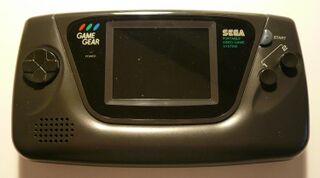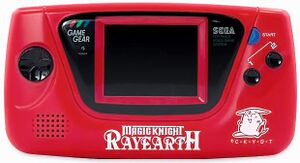Sega Game Gear
From Sega Retro
The Sega Game Gear was a handheld game console and was Sega's response to Nintendo's Game Boy. Work began on the console in 1989. At that point, the project was codenamed Project Mercury.
The system was released on October 6, 1990 in Japan. It was released in North America in 1991, and Europe and Australia in 1992.
The Game Gear was basically a pocket Sega Master System, though it seemed to have arguably better graphics due to the larger color palette. The system is held lengthwise at the sides, preventing the cramping of hands that plagued the Game Boy.
In addition, it featured an advertising campaign that is memorable for being amusing and sometimes bizarre. One commercial shows a dog looking back and forth at both portables while the narrator says, "If you were colorblind and had an IQ of less than twelve, then you wouldn't care which portable you had. Of course, you wouldn't care if you drank from the toilet, either." Another has a gamer hitting himself in the head with a rigid, dead squirrel in order to see color on his Game Boy.
While technically superior to the Game Boy (color graphics, a backlit screen, and an optional TV tuner accessory), it did not gain a significant market share due to problems that plagued the device and the enormous popularity of the Nintendo portable. For example, the device required six AA batteries, but the backlit screen consumed them in three to five hours. It was also somewhat bulky. The Game Boy excelled over the Game Gear and other competitors because of this. Mostly, however, the Game Gear suffered from a lack of quality games, as a result of Sega's failure to enlist as many key software developers as Nintendo.
Because of the similarities between the Master System and the Game Gear, Master System games had been burned on ROMs on Game Gear cartridges. Likewise, a Master System to Game Gear Covertor, the Master Gear, had been released, which allowed Master System games to be played on the Game Gear. The reverse could not be done due to the Game Gear's aforementioned larger color palette. There were also a few third-party Master System converters released for the Game Gear, such as the Gear Master by Beeshu, and an unknown version that held the Master Ssytem cartridge at right-angles to the machine - i.e. directly towards the user.
Today, the Game Gear is widely considered to have been a failure, and unlike the Game Boy no newer versions were released. The Game Gear, however, did better than other portable systems that tried to compete with the Game Boy, with well over 200 games released worldwide. Support ended in 1997 in Western markets (even earlier in Japan), but Majesco released a Core version of the Game Gear in 2000 for a reduced price. However, this version of the Game Gear (which can be identified by its gray ovals as opposed to the RGB ovals present on previous models) is incompatible with the TV tuner accessory.
Contents
See also
Specifications
- Main Processor: Zilog Z80 (8-bit)
- Processor Speed: 3.58 MHz (same as NTSC dot clock)
- Resolution: 160 x 144 pixels
- Colors Available: 4,096
- Colors on screen: 32
- Maximum Sprites: 64
- Sprite Size: 8x8
- Screen Size: 3.2 Inches
- Audio: 4-channel tone generator composed of three square waves and one white noise channel.
- RAM: 24 KB
Accessories
- Game Gear Rechargeable Battery Pack
- Super Wide Gear
- AC adapter (Uses Sega Genesis adapter)
- Master Gear Converter
- Game Gear TV Tuner
- Gear-to-Gear Cable
- Handy Gear
Gallery
- Gamegear eu box.jpg
Game Gear EU box
Miscellaneous
Mega Gear / Mega Game Gear
This was a product supposedly in development early into the Game Gear's life that would allow Genesis users to play their Game Gear titles on their home console, similar to how the SNES could run Game Boy games using the Super Game Boy cartridge. There was very little, if any, official word from Sega about this, aside from very vague references in gaming magazines at the time. With the advent of console emulation, there have been attempts to prove that this method of playing Game Gear games is possible, and have been fruitful: there are utilities available that supposedly convert Game Gear ROMs to Genesis-format ROMs, however their ability is unproven, as they will generally not function in any current emulators.
Wide Gear
This was a nickname for a version of the Game Gear that was only made available to certain gaming magazine officials; the system consists of a standard Game Gear modified with RCA output jacks to allow the machine to connect to a television set or monitor. This would allow clear screenshots for game reviews, previews, and so on, as taking useful screenshots from a standard Game Gear would be very difficult. This TV-Out function is contained on one additional circuit board, which fits inside a convenient battery compartment (the unit then being powered by an AC adapter. Although the gameplay is unaltered through the use of this function, the displayed image is ringed with a background colour, similar to how a PAL console generally displays a small border made up of the currently-loaded background colour. Further points of note:
- It is possible for any technically-minded individual to modify their own Game Gear to have TV-Out, but the ease of this modification depends on the model Game Gear being modified, due to the lack of specific information on the hardware for each of the numerous revisions to the Game Gear through its lifespan.
- An example of this modified Game Gear was shown off in an issue of EGM in America.
Game Gear development hardware
This, along with a TV-Out modified Game Gear, consists of two cards to plug into a PC, an In- Circuit Emulator, a 5.25" floppy (presumably containing an assembler) and a LARGE circuit board - with composite video out.
Coca-Cola Game Gear
This was a limited-edition Japan-only release of the Game Gear as part of a promotion between Sega and Coca-Cola. It is exactly the same as a standard Game Gear console, save from a deep red colour instead of the standard black. It was released with a similarly limited-edition game named 'Coca-Cola Kid'. An example of this unit is on display at the Coca-Cola museum in Atlanta.
In 2005, Coca-Cola released another limited edition handheld, the Coca-Cola Edition of the PlayStation Portable.
MKR Game Gear/Kids Gear
Another Japanese Game Gear variant is Magic Knight Rayearth GG, which sported a red color, and featured the Rayearth logo. Another variant is the so-called 'Kids Gear', released in 1996. This variant is again a standard Game Gear, only renamed and featuring a large Virtua Fighter 2 image fascia, which reflected the pack-in title (Virtua Fighter 2).
External links
- Console Database - Sega Game Gear info and FAQs
- SMS Power - Technical information and more on the Game Gear and its bigger brother, the Master System
| Sega Home Video Game Systems | ||||||||||||||||||||||||||||
| 83 | 84 | 85 | 86 | 87 | 88 | 89 | 90 | 91 | 92 | 93 | 94 | 95 | 96 | 97 | 98 | 99 | 00 | 01 | 02 | 03 | 04 | 05 | 06 | 07 | 08 | 09 | 10 | 11 |
|---|---|---|---|---|---|---|---|---|---|---|---|---|---|---|---|---|---|---|---|---|---|---|---|---|---|---|---|---|
| SG-1000 | SG-1000 II | Mega Drive | Mega Drive II | |||||||||||||||||||||||||
| SC-3000 | Mega-CD | Mega-CD II | Genesis 3 | |||||||||||||||||||||||||
| Sega Mark III | 32X | Dreamcast | ||||||||||||||||||||||||||
| Master System | Master System II | |||||||||||||||||||||||||||
| AI Computer | Game Gear | |||||||||||||||||||||||||||
| Saturn | ||||||||||||||||||||||||||||
| Pico | Beena | |||||||||||||||||||||||||||




